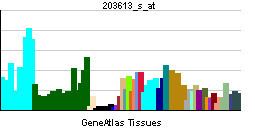Entrez 4712 | Ensembl ENSG00000165264 | |
 | ||
Aliases NDUFB6, B17, CI, NADH:ubiquinone oxidoreductase subunit B6 External IDs MGI: 2684983 HomoloGene: 1864 GeneCards: NDUFB6 | ||
NADH dehydrogenase [ubiquinone] 1 beta subcomplex subunit 6, also known as complex I-B17, is a protein that in humans is encoded by the NDUFB6 gene. NADH dehydrogenase (ubiquinone) 1 beta subcomplex subunit 6, is an accessory subunit of the NADH dehydrogenase (ubiquinone) complex, located in the mitochondrial inner membrane. It is also known as Complex I and is the largest of the five complexes of the electron transport chain.
Contents
Gene
The NDUFB6 gene is located on the p arm of chromosome 9 in position 21.1 and is 19,659 base pairs long.
Structure
The NDUFB6 protein weighs 17 kDa and is composed of 128 amino acids. NDUFB6 is a subunit of the enzyme NADH dehydrogenase (ubiquinone), the largest of the respiratory complexes. The structure is L-shaped with a long, hydrophobic transmembrane domain and a hydrophilic domain for the peripheral arm that includes all the known redox centers and the NADH binding site. It has been noted that the N-terminal hydrophobic domain has the potential to be folded into an alpha helix spanning the inner mitochondrial membrane with a C-terminal hydrophilic domain interacting with globular subunits of Complex I. The highly conserved two-domain structure suggests that this feature is critical for the protein function and that the hydrophobic domain acts as an anchor for the NADH dehydrogenase (ubiquinone) complex at the inner mitochondrial membrane.
Function
The protein encoded by this gene is an accessory subunit of the multisubunit NADH:ubiquinone oxidoreductase (complex I) that is not directly involved in catalysis. However, NDUFB6 is required for electron transfer activity. Mammalian complex I is composed of 44 different subunits. It locates at the mitochondrial inner membrane. This protein complex has NADH dehydrogenase activity and oxidoreductase activity. It transfers electrons from NADH to the respiratory chain. The immediate electron acceptor for the enzyme is believed to be ubiquinone. Alternative splicing occurs at this locus and two transcript variants encoding distinct isoforms have been identified. Initially, NADH binds to Complex I and transfers two electrons to the isoalloxazine ring of the flavin mononucleotide (FMN) prosthetic arm to form FMNH2. The electrons are transferred through a series of iron-sulfur (Fe-S) clusters in the prosthetic arm and finally to coenzyme Q10 (CoQ), which is reduced to ubiquinol (CoQH2). The flow of electrons changes the redox state of the protein, resulting in a conformational change and pK shift of the ionizable side chain, which pumps four hydrogen ions out of the mitochondrial matrix.
Clinical significance
Decreased expression of genes involved in oxidative phosphorylation, including NDUFB6, is associated with insulin resistance and type 2 diabetes. A polymorphism in the promoter region of the NDFUB6 gene resulting in an adenine to guanine shift at rs629566 was shown to create a DNA methylation site that is associated with a decline in NDUFB6 expression in muscle of aging patients.
